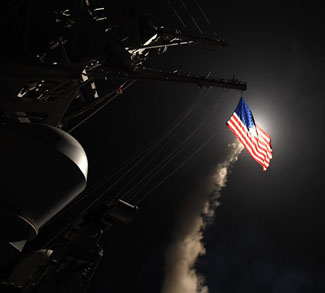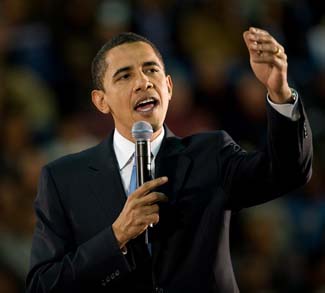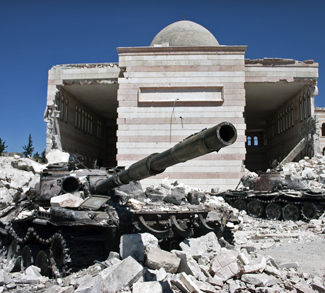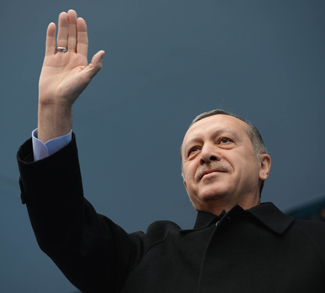Without securing permission from Congress, Donald Trump has broken into the Syrian civil war. The US president ordered a missile strike against the Shayrat air base, one of Syria’s largest, on April 6. The attack was intended as a retaliation for a chemical agent attack allegedly conducted by the Syrian air force against the village of Khan Shaykhun near Idlib. The US strike involved two destroyers launching 59 Tomahawk missiles, though fewer than half appear to have hit their targets. The Shayrat base did suffer some damage, including destroyed fuel depots and MiG-23 planes. According to the Pentagon, the attack was intended to “reduce the Syrian government’s ability to deliver chemical weapons.” Meanwhile, on April 11 during a state visit by Italian president Mattarella, President Putin hinted that the Khan Shaykhun “chemical attack” – less than a week later, few are calling it a sarin gas attack any longer – was a false flag episode meant to discredit the Syrian government and invigorate the opposition. Whether Putin’s suggestion is true or not, he’s certainly right about the revitalization of opposition forces. Whatever truth eventually emerges from Khan Shaykhun, there’s no question that the expected reconciliation between Moscow and Washington will not happen. In a single move, Trump has shown that he intends to follow the usual script that dragged presidents Bush and Obama – and other before them – into the Middle East.
Yet Syrian jets were using the base not 24 hours after the Tomahawk strike. Apart from the minor physical damage to the base, the biggest effect of the missile attack has been to put the United States on a collision course with Russia President Vladimir Putin, who has not wavered in offering Russia’s protection to the regime of President Bashar al-Asad in Syria. The Kremlin reacted to the American raid calling it “an aggression against a sovereign state.” Russia also suspended the memorandum of cooperation on Syria with the United States. The Trump attack ultimately marks a major step backwards in the common fight against terrorism, undermining future relations with Moscow.
The Fallout
It now seems clear that in the case of a new attack on Syria, Russia will respond firmly and proportionally. This could imply the sinking of US or other NATO ships involved in launching further attacks against Syria. Naturally, it would also imply that any US aircraft attacking Syria would be a legitimate target. It’s a dangerous escalation that threatens to drag the world into a much bigger clash between nuclear superpowers, with unimaginable consequences. Trump is probably betting that Moscow, in case of another attack on Syria, would not dare to attack American ships. But in such an event, Putin would face enormous pressure from his own military – and people – to respond forcefully.
For the time being, Russia and Iran maintain that the United States has launched a direct attack against a sovereign Syria and the Assad government. Thus, Trump has sided with the ‘terrorists,’ jeopardizing relations with Moscow. Syria’s allies also insist that a full and impartial investigation into the Khan Shaykhun incident be held. Trump’s missile strike, meanwhile, came just days after the Trump administration announced that Washington would no longer seek to overturn the Syrian regime. Trump’s rapid reaction to the attack might have been a swift and effective ‘tactical’ move from the point of view of internal US politics. Yet it seems like a chaotic strategic move at best. Indeed, more than anything else, Trump’s 59 Tomahawks, costing $1.5 million each, raised an important question about the Trump White House: who’s really in charge? Does President Trump really lead the United States?
The fact that Trump has grown accustomed to swift ratings as a measure of success suggests that he may pull a similar move again if it drives negative poll numbers away. It’s still unclear whether the missile strikes are part of a strategy to initiate a regime change process or are just a one-off. Has Trump used the Tomahawks as a kind of ‘mine canary’ to gauge what kind of appetite Americans have for a wider military intervention in Syria? If so, Trump has forgotten the reasons so many Americans voted for him. They don’t want more wars. The mainstream media loved the move, however. CNN’s Fareed Zakaria proclaimed that Trump “became president” with the strikes. CNBC’s Brian Williams literally waxed poetic, observing the “beauty of our weapons.”
What the handsomely paid Zakaria and Williams, and many others, failed to observe was glaringly obvious. The Syrian army’s alleged use of chemical weapons remains alleged. No proof whatsoever has been presented to confirm that sarin was used. Some say it might be chlorine or phosgene. Moreover, as not so distant history shows, the U.S. has accused regimes it has selected for change of using or developing weapons of mass destruction. When the United States decides to export democracy, its plans are packaged to include a chemical attack of some sort. It’s not clear how the White House will proceed. Trump has not spoken about the Tomahawk launch since the attack – which occurred while he was having dinner with China’s President Xi Jinping. That may have been a deliberate affront as Syria has enjoyed Chinese support. Yet members of Trump’s staff, and his ambassador to the UN Nikki Haley, hinted that more strikes would come.
The big question is: Has Trump finally caved to pressure from the anti-Russian Republicans and Democrats?
If Trump intends the attack against the Shayrat base to be part of a wider strategy, then he’s directing a movie whose script audiences have seen before. Trump might want Syria to be the sequel of Serbia, Iraq, or Libya. The plot goes something like this: attribute guilt a priori, announce you have proof – but don’t bother to present it to the world – launch an attack and deploy the opposition. Russia’s military presence, however, disrupts the linearity of this plot. If Russia wants to protect its interests in the area – the naval base of Tartus and the air base near Latakia – the United States risks an escalation of tensions not seen since the Cuban missile crisis of 1962. The risk Trump takes by reviving the regime change option falls nothing short of World War 3. Alternatively, if Trump contains the strike to the tactical – for domestic political consumption – as Bill Clinton did when he attacked a Sudanese alleged WMD factory in Khartoum in 1998 to retaliate against blasts at U.S. embassies in Kenya and Tanzania, then the episode might not involve any follow-up actions.
Ultimately, the attack against Syria shows that Trump does not decide all that much in the United States. Trump had said last week that the real problem was not Assad, but ISIS and terrorism in general. It was not a priority for him to change the government in Damascus. The fact that Trump could find it so easy to pursue a diametrically opposite policy in a matter of 48 hours suggests he has little control. He has caved to pressure from various elements of the Pentagon, perhaps the CIA and certainly to Republican and Democratic members of Congress. The demotion and ousting of close Trump advisors like Steve Bannon and Michael Flynn – who was strongly opposed to a Syrian intervention – might be taken as the first hints of the Trump shift.
For President Trump, it might be the beginning of the end. His shift in favor of military threats in Syria – and North Korea – and away from ‘America First’ could cost him considerable domestic support. His military advisors, Generals Mattis and McMaster, may have urged him to launch an attack, persuading him it would help appease domestic tensions over Russia-gate, which would then allow him to concentrate on making ‘America great again.’ Trump’s detractors on April 5 became his supporters on April 6. Hillary Clinton, John McCain, and Chuck Schumer now applaud what they believe was his first presidential action: attacking a sovereign state and killing civilians. This is more symptomatic of the United States’ conviction of its global policeman role than any specific Trump fault. But, unlike other conflicts, Trump has attacked a sovereign country backed by Russia (and Iran) directly and overtly. Even if Putin – and maybe even Iran – wanted to start reducing their involvement, they can’t back away now. Russia wants to reassert its global superpower role and caving to US demands – even worse, US accusations of abetting a chemical weapons attack – cannot happen. That is also why it’s hard to believe the accusations leveled against the Syrian government and why it’s so important to allow an independent investigation of the Khan Shaykhun incident.
The risk now is that in launching Tomahawk missiles against Syria, Trump has hit a hornet’s nest. No matter the implications and machinations in Washington, the various al-Nusra, al-Qaida, and even ISIS terrorists on the ground in Syria now know that they can stage poison gas attacks, using them as a kind of ‘bat-signal’ to prompt a US attack against Syrian government forces. The ‘chemical’ formula is easy: stage chemical attack, bring White Helmets and blame Bashar al-Assad. The media and political circuit will lap it up and do what it does best. Fareed Zakaria will declare the inevitable military response as oozing presidential greatness. Trump may have been sucked in by the media – whose attention he craves – and the proverbial neocons who have tried for the past six years to get the United States militarily engaged in Syria. Trump has thus sold his soul, and his presidency, to them in the hope of saving both.
The opinions, beliefs, and viewpoints expressed by the authors are theirs alone and don’t reflect any official position of Geopoliticalmonitor.com.




